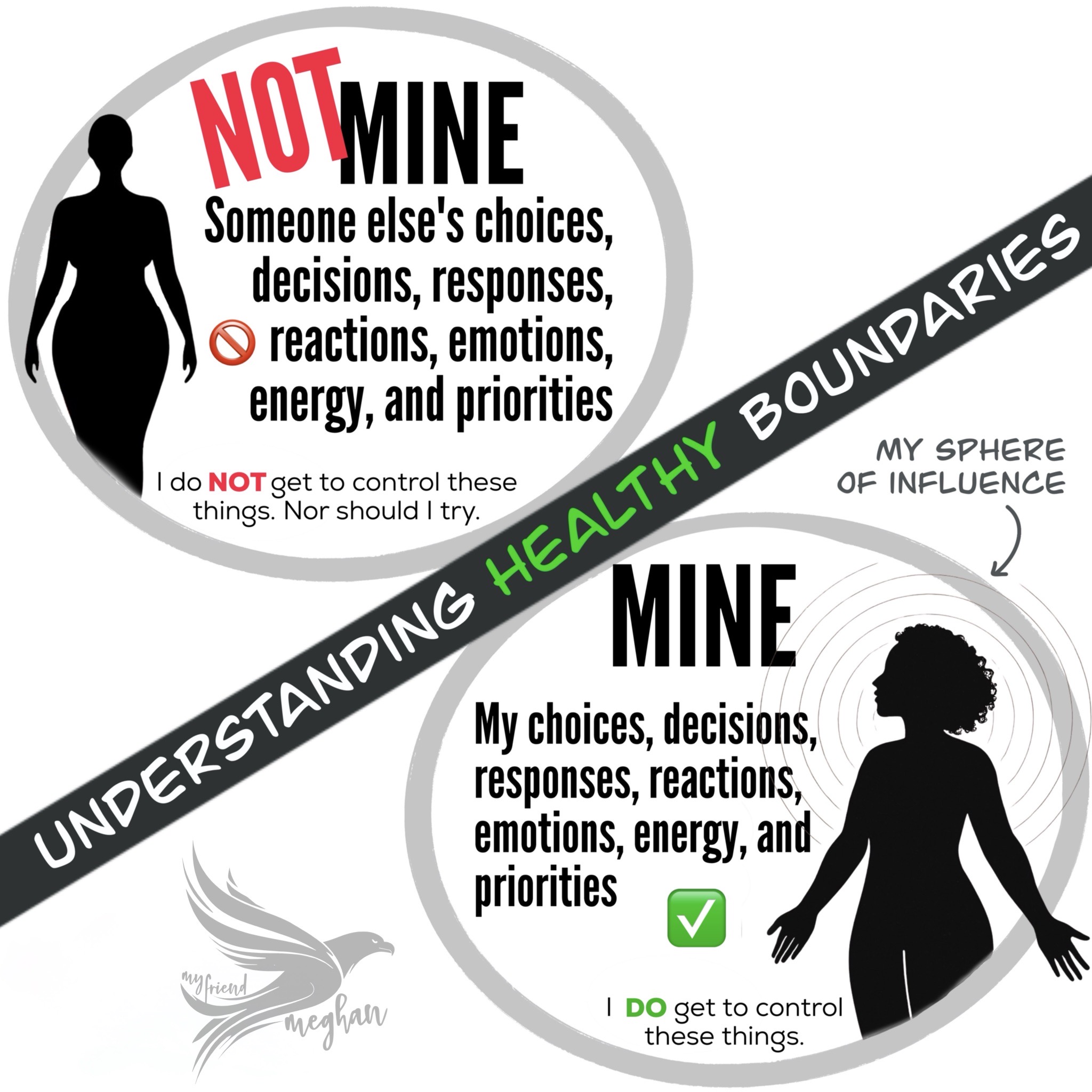There’s a kind of peace that comes when you realize—deep in your bones—that not everything is yours to carry. For much of my life, I didn’t understand that. I tried to anticipate, manage, soften, or redirect what I sensed other people might feel in response to me. It wasn’t because I didn’t care—it’s because I cared so much that I found myself stepping into emotional territory that wasn’t mine.
Eventually, I started noticing the toll it was taking. I was constantly drained, questioning myself, and subtly shape-shifting in ways that felt misaligned. It wasn’t until I began exploring healthy boundaries that I recognized what was really happening: I wasn’t just carrying my own emotional load—I was dragging around everyone else’s too.
The Sphere of Influence Framework
When thinking about healthy boundaries, it helps to visualize it with a simple diagram. Picture two spheres: one that represents everything that’s within your sphere of influence (your thoughts, your energy, your choices, your emotions), and another that belongs to anyone else (everyone has their own). There’s a clear dividing line between them—that is the boundary. And that boundary is what protects your peace—and respecting it is what allows true connection to thrive.
What’s Yours, What’s Not
Healthy boundaries are about maintaining personal sovereignty—determining what it is right for someone to be involved in and what it is not. That goes both ways: whether it’s someone else stepping into your sphere, or you stepping into theirs. That moment when you censor yourself to avoid someone’s reaction? That’s crossing into their side. That impulse to manage how someone else feels about your truth? That’s outside your sphere of influence, so it’s not yours to even try to manage.
Fear Often Fuels the Impulse to Cross the Line
At the root of our desire to manage what isn’t ours—whether it’s someone else’s emotions, choices, or reactions—is often fear. Fear of being misunderstood. Fear of loss. Fear of judgment. This kind of fear-based interference stems from a constricted state of mind and energy. When we’re gripped by the need to control outcomes, it’s often a signal that we need to elevate our thought — moving out of constricted, fear-based energy and returning to an expanded, trust-filled state.
Otherwise, the very fear driving us can activate the Pygmalion effect (self-fulfilling prophecy), where the negative assumptions we carry end up shaping the outcome. If we expect rejection or misinterpretation, we often unconsciously create the very dynamics that lead to them. By returning to love, trust, and self-responsibility, we release the need to interfere and allow healthier patterns to emerge. By staying in our own sphere of influence and releasing attachment to what isn’t ours, we foster clarity, peace, and genuine connection.
Letting go of outcomes we can’t control is an essential part of emotional sovereignty—the recognition that each person is responsible for their own experience. That doesn’t mean we act carelessly or without compassion. Quite the opposite. It means we offer truth with love and allow others the dignity of their own response.
Control and Free Will Cannot Coexist
This is where the deeper cost of fear-driven control becomes clear.
When we attempt to manage someone else’s reaction, it’s often an unconscious attempt to avoid rejection, conflict, or shame. But manipulation—even subtle—undermines trust. People can feel it. And whether they articulate it or not, they will pull back.
When we operate from control, we’re violating a sacred principle: free will. And let’s be honest—none of us enjoy having our autonomy infringed upon. When someone tries to orchestrate our response, it doesn’t feel like love. It feels like being managed. Like being boxed in. Like losing choice.
The irony is, the more we try to force connection by controlling outcomes, the more we create distance. The more we let go and trust the process, the more room we create for authentic restoration to occur in the right time and way.
Sovereignty Makes Space for Restoration
Misunderstandings will happen. So will temporary disconnects. But when you honor your own boundaries and respect others’ right to theirs, you leave the door open for future reconnection. Manipulation and overreach may get immediate compliance, but they rarely leave space for mutual healing or growth.
That’s why this key—understanding healthy boundaries—is foundational to empowered communication. It’s not just about protection. It’s about integrity, trust, and honoring the sacred autonomy we each carry.
As I shared in my original post on healthy boundaries, this key also asks us to observe our inner patterns—what we allow ourselves to dwell on, obsess over, or try to fix. The more we stay within our own sphere, the more grounded we become. The more grounded we are, the less we need to control.
This shift in mindset echoes a broader truth that runs through all 13 Empowered Communication keys: when we act from alignment rather than fear, our energy changes—and so do our relationships.
Actionable Insights
- Visualize your sphere of influence. In a moment of interpersonal tension, pause and mentally draw the boundary: What’s mine to own? What’s theirs to navigate?
- Release control to restore connection. Are you speaking or acting in a way that attempts to control someone else’s emotional response? What would it look like to let that go?
- Trust the process of free will. If a misunderstanding occurs, can you honor someone’s right to process it in their own way—without manipulating or fixing it?
- Stay anchored in your truth. When you communicate from love and alignment, you don’t need to chase understanding. Trust that what is meant for you will remain.
Healthy Boundaries and Letting Go is the 4th of the 13 Keys for Empowered Communication.
The 13 Keys are:
- You Are Responsible for the Energy You Bring
- Power vs. Force
- Energy as Currency
- Healthy Boundaries and Letting Go
- Release the Illusion of Control
- Release and Transmute Energy
- The Role of Forgiveness in Energy Release
- Know Your Own Weaknesses
- The Importance of Self-Validation
- Thought Patterns Shape Reality
- Manifestation and Mental Focus
- Trust the Timing of Others’ Journeys
- The Art of Non-Reaction


Leave a Reply